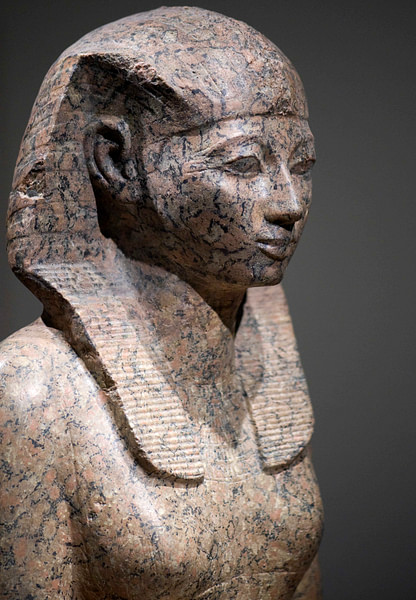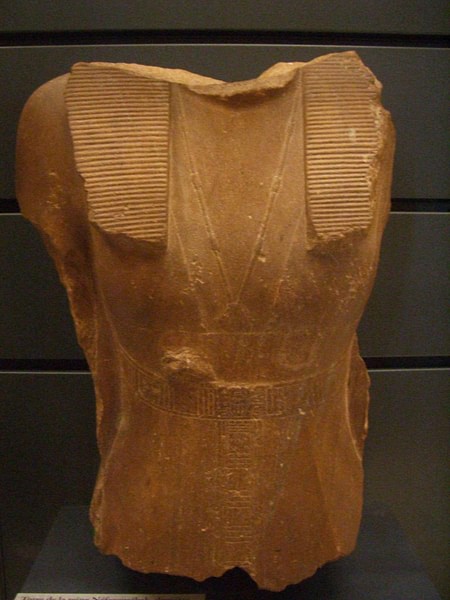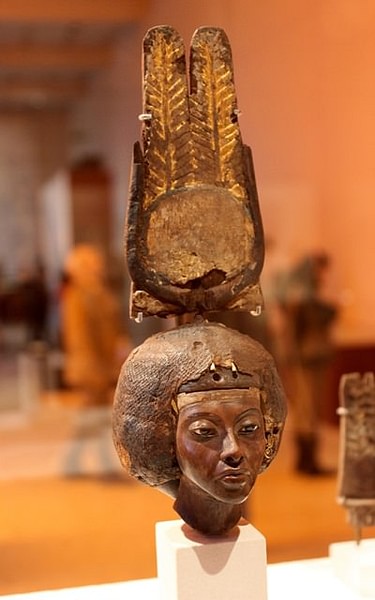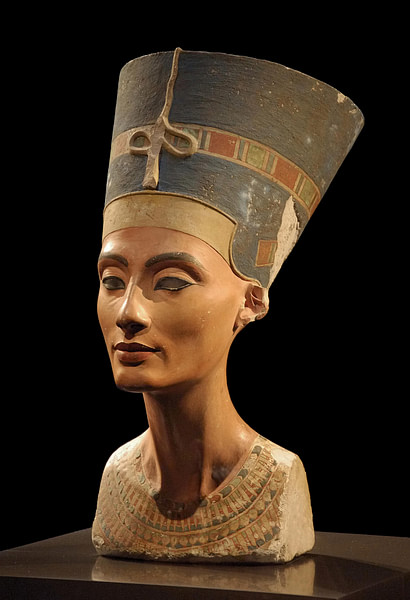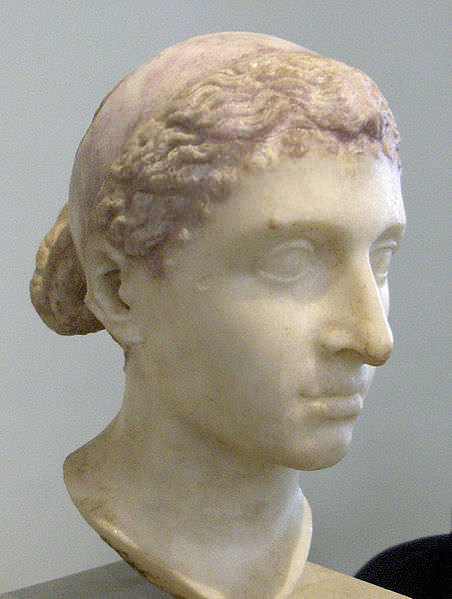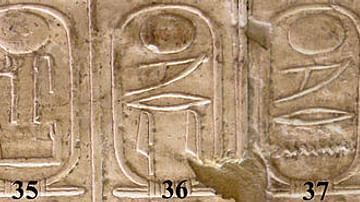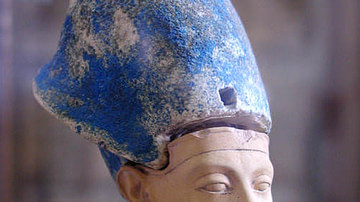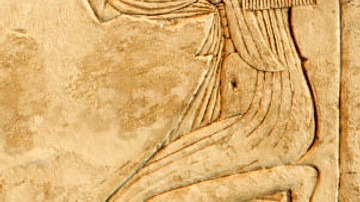Women in ancient Egypt had more rights than in any other ancient culture and were valued with greater respect. This is evident not only in the physical evidence and inscriptions but in their religion. Some of the most powerful and important deities in the Egyptian pantheon are female and some versions of the creation myth itself present the goddess Neith, not the god Atum, as the creator.
The most popular and influential religious tale in Egypt was the story of Osiris and how he was brought back to life by his sister-wife Isis. Although Osiris would eventually figure in many of the most important religious ceremonies, symbols, and beliefs of the Egyptian culture, it is actually Isis who is the central character of the story. Osiris plays a fairly passive role throughout, but Isis travels out of the country to find the body of her husband, brings it back, and brings him to life. The cult of Osiris would eventually, in fact, become the cult of Isis, the most popular religion in Egypt and then in the Roman Empire until it was suppressed after the rise of Christianity.
It is hardly surprising, therefore, that there were a number of important female rulers throughout the history of Egypt. These queens, or powerful women who influenced policy directly, were:
- Neithhotep (Old Kingdom)
- Merneith (Old Kingdom)
- Heterpheres I (Old Kingdom)
- Nitocris (Old Kingdom)
- Sobeknefru (Middle Kingdom)
- Ahhotep I (New Kingdom)
- Hatshepsut (New Kingdom)
- Tiye (New Kingdom)
- Nefertiti (New Kingdom)
- Nefertari (New Kingdom)
- Amenirdis I (Third Intermediate Period)
- Nitocris I (Third Intermediate Period)
- Cleopatra VII (Ptolemaic Period)
The best known of these, of course, is Cleopatra VII (c. 69-30 BCE), who was not actually Egyptian but Greek. Long before she came to the throne, however, these other Egyptian women had already held the positions of regent, God's Wife of Amun, and even reigning monarch a number of times.
There were many queens throughout Egypt's history, but some stand out for particular accomplishments or influence while others are notable because they ruled alone by their own authority. The noble women discussed here should not be regarded as a tiny minority of powerful female figures in Egypt but rather as highlighting those whose reigns cause them to stand out from the many who left no inscriptions or were passed over by later scribes.
Early Dynastic Period & Old Kingdom
The first queen, who may also have ruled alone, was Neithhotep of the Early Dynastic Period in Egypt (c. 3150 - c. 2613 BCE). Her dates are difficult to determine, as are any details of her life, but she lived in the early part of the First Dynasty (c. 3150 - c. 2890 BCE). She was the wife of the first king of Egypt, Narmer (also known as Menes). Recent claims that she was actually the wife of the second king, Hor-Aha, ignore the possibility that Hor-Aha (also known as Menes) was the same person as Narmer.
Neithhotep is usually regarded as the mother of Hor-Aha and may have ruled on her own after Narmer's death and before Hor-Aha was old enough to take the throne. There is no record of her rule but her tomb at Naqada, discovered in the 19th century CE was so large that the archaeologists classified it as that of a king and believed Neithhotep to be Narmer's successor or, at least, a king whose name was left off the official list compiled by Manetho in the 3rd century BCE.
Further evidence of her stature is that her name has been found inscribed on a serekh more than once. The serekh was a clay representation of the royal house and courtyard on which a king's name would be written before the development of the better-known cartouche.
Another queen from the same period, who may also have ruled on her own, is Merneith (c. 2990 BCE) whose name also appears on a serekh. She was the wife of Djet and mother of the king Den (c. 2990-2940 BCE). Merneith ruled as regent after Djet's death when Den was still young but could have also ruled as king as evidenced from her grave goods.
In the 4th Dynasty, which begins the Old Kingdom of Egypt (c. 2613-2181 BCE), the queen Heterpheres I was the wife of king Sneferu (c. 2613-2589 BCE), the first to build a true pyramid in Egypt, and mother of Khufu (2589-2566 BCE) who built the Great Pyramid of Giza. Heterpheres I exerted considerable influence over her son who had her now-famous tomb built near his own pyramid complex. The details of her reign and rise to power are unclear. She could have been the daughter of Huni (c.2630-2613 BCE), the last king of the Third Dynasty, and if so, her marriage to Sneferu allowed for a smooth transition between the two dynasties.
The most controversial queen of the Old Kingdom is Nitocris (2184-2181 BCE) because scholars continue to debate whether she actually existed. She is mentioned by Manetho in his King List and also appears in the Turin King List and Abydos King List and is also mentioned by Eratosthenes of Cyrene (276-194 BCE) in his list of Egyptian monarchs. She left no inscriptions or monuments, however, and there is no later reference to her in Egyptian history. Her story is only told by the Greek historian Herodotus (484-425/413 BCE) in Book II.100 of his Histories:
In all these many generations there were eighteen Ethiopian kings, and one queen, native to the country; the rest were all Egyptian men. The name of the queen was the same as that of the Babylonian princess, Nitocris. She, to avenge her brother (he was king of Egypt and was slain by his subjects, who then gave Nitocris the sovereignty) put many of the Egyptians to death by treachery. She built a spacious underground chamber; then, with the pretence of inaugurating it, but with quite another intent in her mind, she gave a great feast, inviting to it those Egyptians whom she knew to have had the most complicity in her brother's murder; and while they feasted, she let the river in upon them by a vast secret channel. This was all that the priests told of her, except that when she had done this she cast herself into a chamber full of hot ashes, to escape vengeance.
No ancient sources have been found to corroborate Herodotus' account and, lacking any Egyptian records of such a queen, scholars concluded that she was a myth or the result of an ancient spelling error. The Egyptologist Percy E. Newberry, in 1943 CE, argued for her authenticity, but the majority of Egyptologists continued to regard her as mythical until fairly recently. Although the debate continues, Nitocris is now more widely accepted as the first Regnal Queen of Egypt.
First Intermediate Period & Middle Kingdom
The First Intermediate Period of Egypt (2181-2040 BCE) was a time of a weak central government following the collapse of the Old Kingdom. Records from this time regarding monarchs, as well as other aspects of history, are often confused and only stabilize in the Middle Kingdom (2040-1782 BCE). The Middle Kingdom of Egypt is established with the 11th Dynasty by the Theban prince Mentuhotep II (c. 2061-2010 BCE) who was hailed as a "second Menes" for uniting the country. The 11th Dynasty lay the groundwork for the next which is considered one of the greatest periods in Egyptian history.
The 12th Dynasty of Egypt is famous for its powerful literature, inspiring artwork and monuments, and military campaigns which helped foster a stable and affluent society. It is also known for its last monarch, Queen Sobeknefru (c. 1807-1802 BCE), the first woman known to rule Egypt since Nitocris. Sobeknefru, unlike the later female pharaoh Hatshepsut (1479-1458 BCE), governed as a woman in feminine attire.
This aspect of her reign is especially interesting since she made no effort to carry on the tradition of a male on the throne and there is no evidence of resistance to her rule or her choice to reign as a woman. Sobeknefru either built the temple of Sobek in the city of Crocodilopolis or founded that city just south of Hawara as well as commissioning other building projects in the tradition of earlier great monarchs. She died without an heir and rule passed to Sobekhotep I (c. 1802-1800 BCE) who initiated the 13th Dynasty.
The 13th Dynasty was weaker than the 12th and allowed for a foreign people, the Hyksos, to gain power in Lower Egypt and eventually rule over a large area from the Delta southwards. This era is known as the Second Intermediate Period of Egypt (1782 - c. 1570 BCE) in which the central government was again weak and the Hyksos held the northern regions while the Nubians expanded their control of the south. Thebes stood between these two and, in c. 1570 BCE, the Theban prince Ahmose I (c. 1570-1544 BCE) drove the Hyksos and Nubians out of Egypt and united the country under his rule, initiating the period of the New Kingdom (c. 1570-1069 BCE). Records from the Second Intermediate Period, as with those of the end of the Old Kingdom and First Intermediate Period, are fragmented and often unclear and there are no women mentioned as significant rulers.
The New Kingdom
The New Kingdom of Egypt, however, saw a number of women in positions of power from the very beginning. The mother of Ahmose I, Queen Ahhotep I (c. 1570-1530 BCE) put down a rebellion of Hyksos sympathizers while Ahmose I was campaigning against the Nubians in the south. She commanded considerable respect from the military and operated independently and successfully, without consulting with her son.
Ahhotep I held the position of God's Wife of Amun, an honorary title since the Middle Kingdom which was largely ceremonial. She passed this position on to Ahmose I's wife, Ahmose-Nefertari, under whose authority it became one of the most powerful political and religious offices in the country. The God's Wife of Amun was the female counterpart to the high priest, could enter into the inner sanctum of the god, and was able to make sacrifices and participate in the holy processions. She was also rewarded with tax-exempt land, gold, silver, servants, and the offerings made to the temple. Ahmose-Nefertari, and many of those who held the position after her, exerted significant influence over the country and, in one famous example, came to rule.
Hatshepsut (1479-1458 BCE) is one of the best-known female monarchs of Egypt. She was the daughter of Thutmose I (1520-1492 BCE) and came to the throne as regent for Thutmose III (1458-1425 BCE). She had also been a God's Wife of Amun but handed that title down to her daughter Neferu-Ra shortly after she assumed rule. Hatshepsut is among the most powerful and successful in Egypt's history. The country flourished under her reign, and she was responsible for successful trade (such as her famous expedition to the Land of Punt), military campaigns, and great monumental constructions in addition to adding on to the Temple of Amun at Karnak.
Unlike Sobekneferu, Hatshepsut chose to rule as a man and is consistently represented as male throughout most of her reign. Why she chose to do this is not known, but after her death, her inscriptions and monuments were defaced of destroyed. The reason for this is also unclear, but it is thought it was done to prevent future women from assuming the position of pharaoh and ruling as a man.
Queen Tiye (1398-1338 BCE), the wife of Amenhotep III (c.1386-1353 BCE) who ruled over one of the most prosperous eras in Egyptian history, did not rule directly as a man but was certainly a powerful force. Tiye frequently assisted her husband in matters of state, met with diplomats, and carried on her own correspondence with other foreign leaders. She was not only a formidable presence at Amenhotep III's court but continued to exert her influence over her son, Akhenaten (1353-1336 BCE), who would have a dramatic impact on Egyptian history.
Akhenaten, known as the 'heretic king,' abolished the traditional religious practices of Egypt and closed the temples when he mandated the worship of a single god, the Aten. He also moved the capital to a new city he commissioned, Akhetaten, where he busied himself with his own affairs and largely neglected the business of running the country. He may have done this not from genuine religious zeal but to curb the power and influence of the priests of Amun whose wealth had been a constant threat to the throne since the time of the Old Kingdom. Tiye had recognized this problem earlier and may have suggested Akhenaten's solution to it.
Akhenaten's wife, Nefertiti (c. 1370-1336 BCE) took over his responsibilities once he moved the capital to his own private city. Her involvement with state affairs is evidenced by a number of letters from her to foreign dignitaries. Nefertiti's image is among the most famous from ancient Egypt owing to the bust made of her by the sculptor Thutmose, now in the Egyptian Museum of Berlin. When Akhenaten withdrew from his role as monarch, Nefertiti seems to have been the one who stabilized the government and appeased the foreign powers involved with Egypt.
In the 19th Dynasty, Nefertari (c. 1255 BCE) was the queen of Ramesses II (1279-1213 BCE) and was equally influential during his administration. Nefertari (also a former God's Wife of Amun) was highly educated and participated regularly in affairs of court. Ramesses II built his famous temple of Abu Simbel in her honor and she is among the best-known queens from the period.
The 19th Dynasty ends with the reign of another powerful queen Twosret (also known as Tawosret, 1191-1190 BCE). She was the queen-mother of the child-king Siptah, who died when he was only sixteen. Twosret then ruled Egypt until her death in 1190 BCE when power passed to Setnakhte (1190-1186 BCE) who founded the 20th Dynasty, the last to rule before the New Kingdom disintegrated into the Third Intermediate Period (c.1069-525 BCE).
The Third Intermediate Period & Cleopatra VII
The era known as the Third Intermediate Period of Egypt is often characterized as a bleak dissolution of Egyptian culture primarily because there is no glorious time of a united Egypt under a strong central government which follows it. The period was hardly as chaotic and dismal as many scholars have made it appear, however, and there were a number of women who held significant power in the course of it.
Among the most impressive is the God's Wife of Amun, and daughter of King Kashta (c. 750 BCE), Amenirdis I (714-700 BCE). Amenirdis I controlled Thebes through her position as God's Wife of Amun and effectively ruled Upper Egypt. Her power was so great that she was able to stabilize the country for her brother Shabaka (721-707 BCE) during his campaigns in Lower Egypt to unite the country.
Later, another God's Wife of Amun, Nitokris I (also known as Neitiqert and Shepenwepet III, 655-585 BCE) would become so powerful that she ruled over seven districts in Upper Egypt and four in Lower Egypt. She was the wealthiest of all the God's Wives in the history of the title and commanded respect, and offerings, from the priesthood and royalty. Nitokris I is also among the most famous God's Wives from inscriptions at Karnak and elsewhere which relate how she became a God's Wife, the enormous amount of tribute she was able to command, and the areas she ruled over. Her designation as "Nitokris I" has perhaps contributed to the opinion of some scholars that Nitocris of the Old Kingdom was mythic, but this is speculative.
The Persian Invasion of 525 BCE ended the position of God's Wife of Amun, and no other female monarchs or women of title are recorded until the Ptolemaic Dynasty (323-30 BCE) and the reign of Cleopatra VII. Under the latter part of the Ptolemaic Dynasty Egypt was steadily declining until Cleopatra VII reversed that trend. She, like Nefertari, Nefertiti, and others, was well educated, spoke a number of different languages, and displayed great skill and talent as a politician. Her downfall was her adversary Octavian (later Augustus Caesar, 27 BCE-14 CE) who was not as malleable as Julius Caesar or Mark Antony, her two former lovers, had been. After defeating Cleopatra and Antony at the Battle of Actium, Octavian would become the first emperor of Rome and annex Egypt, initiating the country's Roman Period.
Cleopatra VII made a lasting impression on history and today is probably the first name which comes to mind when one thinks of an Egyptian queen. There were many who came before her, however, who made her reign possible and many others whose names have been lost who no doubt contributed significantly to the grand civilization of ancient Egypt.
